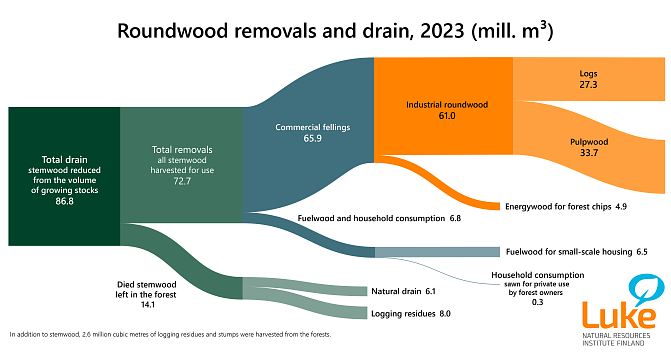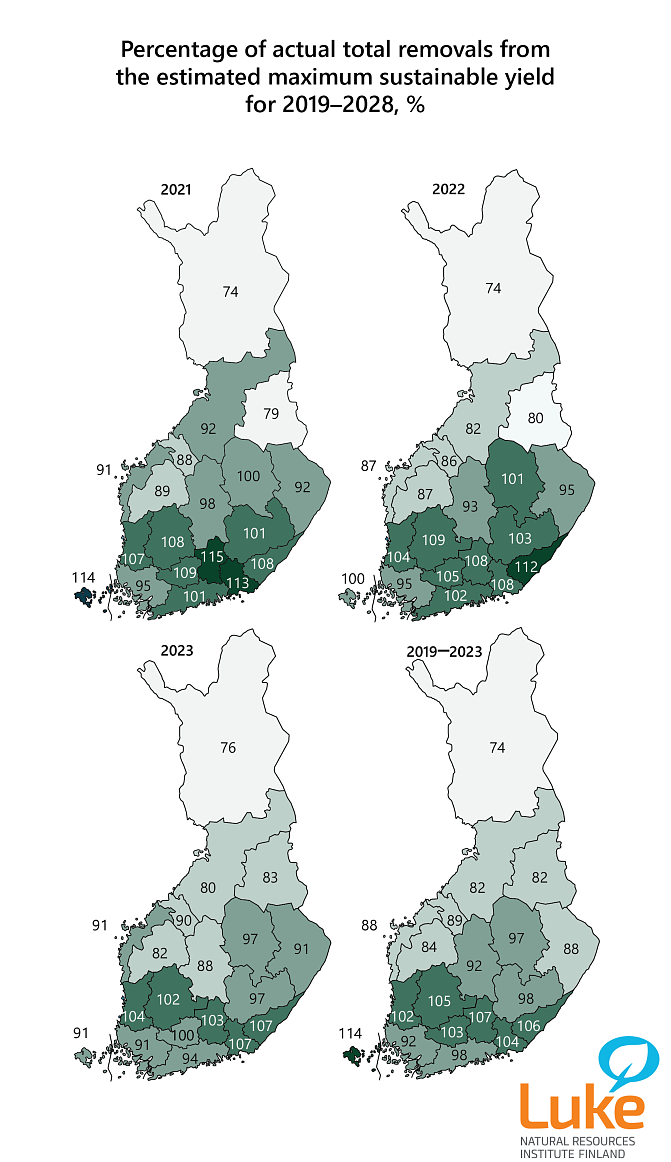Total roundwood removals and drain by region 2023
In 2023, a total of 72.7 million cubic metres of stemwood was felled in Finland, 84% of which was industrial roundwood and 16% energywood. The total amount felled was 3% lower than the year before. The volume of total drain decreased to 86.8 million cubic metres.
Total roundwood removals
- In 2023, 72.7 million cubic metres of stemwood was harvested for use. This is a decrease of 2.4 million cubic metres, or 3%, from the previous year. It was two percent below the average level of the previous five years.
- Logs and pulpwood accounted for 61.3 million cubic metres or 84% of stemwood removals. A total of 61.0 million cubic metres was felled for the forest industry or for export, and 0.3 million cubic metres for household consumption of forest owners. Log removals decreased by 4% from the previous year, and the volume of pulpwood fell by 5%.
- The remaining 11.4 million cubic metres was energywood, , i.e. stemwood to be used as fuelwood in residential housing or as wood chips in heat and power plants. Its volume increased by 5% from the previous year. In addition, 2.6 million cubic metres of logging residues and stumps were harvested for burning, which are not included in the total stemwood removal statistics.


Use of the estimated harvesting potential
- Luke has estimated that the sustained yield of Finnish forests during the period from 2019 to 2028 is on average 79.8 million cubic metres of stemwood per annum. Over the past five years, the harvesting rate for the country as a whole has fluctuated between 86 and 96% each year, averaging 92% of the estimated potential. In Northern Finland, the three northernmost counties, the average harvest has been 79% of the estimated level. In the rest of Finland, logging has been much higher, at 96% of the sustained yield.
- In 2019-2023, the felling volumes of stemwood exceeded the sustained yield in seven regions of Southern and Central Finland. In Åland, forests were devastated by the storms in 2019 and the average harvesting in the period under review was 14% above the harvesting potential estimate. In Satakunta, Kanta-Häme, Pirkanmaa, Päijät-Häme, Kymenlaakso and South Karelia, the exceedances were between 2% and 7%.
- In 2023, the country as a whole fell short of the estimated harvesting potential by 7.1 million cubic metres, so 91% of the potential was used. Logging exceeded the estimated level in a total of six regions in Mainland Finland, which were the same as in the longer period under review. In the region south of Northern Finland, on average 95% of the estimated potential was exploited.


Total drain
- With the reduction in removals, total drain fell by 3% to 86.8 million cubic metres. In addition to stemwood felled for use, this included eight million cubic metres of logging residues and six million cubic metres of naturally died stemwood left in forests.
- Based on the National Forest Inventory, the annual increment of the growing stock totals 104 million cubic metres. This means that the total volume of growing stock increased by approximately 17 million cubic metres.
Final statistics for 2023 were clearly higher than preliminary data
Preliminary data on fellings and drain in 2023 were published in February. According to the final statistics for commercial fellings, 2.4 million cubic metres more logs and pulpwood was harvested than forecast, and 1.7 million cubic metres more energywood. These changes are also reflected in the statistics on removals and drain. The reason for the revision of the data is that the final statistics are calculated from data provided by more than 120 companies, while monthly data from only about 25 companies are available for the preliminary data.
Allow functional cookies to show the embedded graph.


